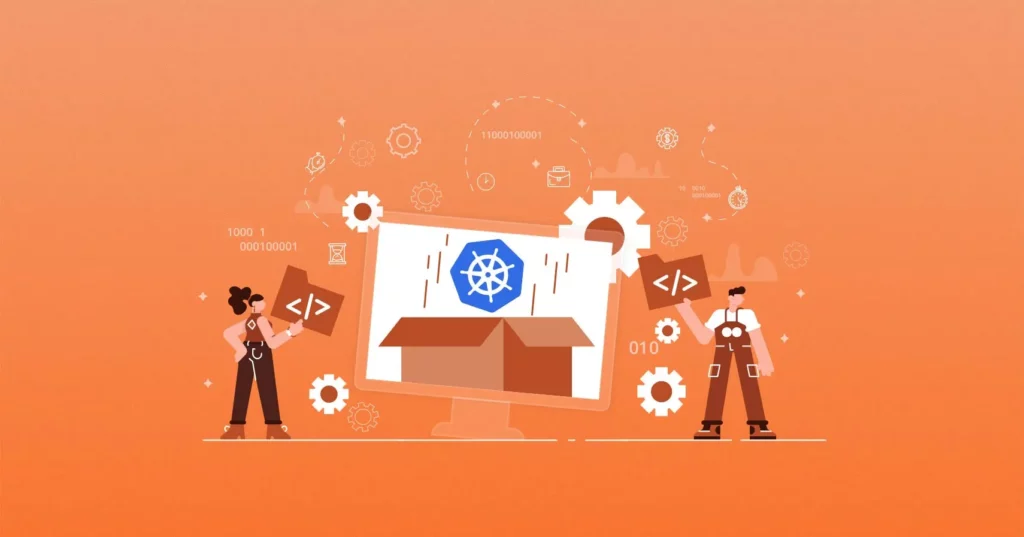TOP Kubernetes Interview Questions & Answers [UPDATED 2024]

Table of content
Interviews are commonly acknowledged to be a difficult procedure.
Kubernetes job interview is considered to be one of the most nerve-racking interviews, requiring tremendous and intensive preparation. As a result, we have produced this article to delve further into the complexities of Kubernetes interview questions in order to facilitate the process. Prior to this, let’s see what Kubernetes is in the first place.
Kubernetes is an open-source platform for managing containerized workloads and services that allows for declarative setup as well as automation. It has a huge and quickly expanding ecology. Services, support, and tools for Kubernetes are widely accessible. Kubernetes is a Greek word that means “helmsman” or “pilot.” The nickname K8s comes from counting the eight letters between the letters “K” and “s.” In 2014, Google made the Kubernetes project open source. Kubernetes blends over 15 years of Google expertise running production workloads at scale with best-of-breed community ideas and practices. You may be wondering what Kubernetes is used for? Hence, before we look into Kubernetes interview questions and answers, let’s answer this question.
Containers are an excellent method to package and run your programs. You must manage the containers that execute the apps in a production environment to guarantee that there is no downtime. For example, if one container fails, another must start. Wouldn’t it be better if a system managed this behavior? That is when Kubernetes comes in! Kubernetes provides a platform for running distributed systems in a resilient manner. It handles scaling and failover for your application, as well as providing deployment patterns and other features. Kubernetes, for example, can simply manage a canary deployment for your system.
As already mentioned, we have defined what Kubernetes is and why we do need it. Now, let’s time-travel into the future and take a glance at the TOP Kubernetes interview questions and answers.
TOP Kubernetes Interview Questions and Answers
Note: the information included within this article is carefully written by professional hiring managers who have been in the field for years. That is to say, every Kubernetes interview question and answer earned a certain amount of dedication and consideration in the process of writing it. Make sure to take notes.
What separates Kubernetes from Docker Swarm?
Answer: (This is a basic Kubernetes interview question) Here is a table explaining the differences between Kubernetes and Docker swarm in terms of installation, autoscaling, and much more than you can see below.

How do Kubernetes and Docker relate to each other?
Answer: It’s well known that Docker manages the lifetime of containers and that a Docker image creates runtime containers. We use Kubernetes because these separate containers must interact. Docker creates the containers, while Kubernetes allows them to interact with one another. As a result, we use Kubernetes to manually link and orchestrate containers operating on various hosts.
What is Container Orchestration?
Answer: Consider a case in which an application has 5-6 microservices. These microservices are now in separate containers, but they will be unable to interact without container orchestration. So, much as orchestration in music refers to all instruments performing in unison, container orchestration refers to all services in separate containers working together to meet the demands of a single server.
Why do we need Container Orchestration for?
Answer: Container orchestration automates container deployment, management, scalability, and networking. Container orchestration is useful for businesses that need to deploy and manage hundreds or thousands of Linux® containers and hosts. Container orchestration is useful in any situation where containers exist. It can help you in deploying the same program across many environments without having to rewrite it. Also, containerized microservices make it easier to orchestrate services like storage, networking, and security.
Explain how Kubernetes simplify containerized Deployment?
Answer: Because a typical application would consist of a cluster of containers running on various hosts, all of these containers would need to communicate with one another. To do this, you’ll need a large system that can load balance, scale, and monitor the containers. Kubernetes must be your option to ease containerized deployment because it is cloud-agnostic and can operate on any public/private provider.
What is Google Container Engine GKE?
Answer: Google Container Engine (GKE) is an open-source container and cluster management platform. This Kubernetes-based engine only supports clusters that run on Google’s public cloud services.
What is Heapster?
Answer: Heapster is a cluster-wide data aggregator powered by Kubelet, which runs on each node. This container management tool works as a pod in a Kubernetes cluster, just like any other pod. So, using an on-machine Kubernetes agent simply identifies all nodes in the cluster and queries use statistics from the Kubernetes nodes in the cluster.
Define what is Kubelet?
Answer: Kublete refers to an agent service that runs on each node and allows the slave and master to interact. As a result, Kubelet examines the PodSpec’s description of containers and ensures that the containers defined in the PodSpec are healthy and operational.
Briefly tell me about the working of the master node in Kubernetes?
Answer: The Kubernetes master is in charge of the nodes, which contain containers. Individual containers exist now within pods, and each pod can hold a different number of containers depending on the setup and requirements. The pods are then scheduled on the nodes and assigned to these nodes depending on the resource needs. The Kube-Episerver is responsible for establishing communication between the Kubernetes node and the master components.
Tell me about the role of Kube-Episerver and Kube-scheduler?
Answer: The Kube–Episerver is the front-end of the master node control panel and follows the scale-out design. This exposes all the Kubernetes Master node components’ APIs and is in charge of communicating between Kubernetes Node and Kubernetes Master components.
The Kube-Scheduler is in charge of workload allocation and management on worker nodes. As a result, it chooses the best node for running the unscheduled pod based on resource requirements and maintains track of resource usage. It prevents workloads from being heavy on already loaded nodes.
Can you brief me about the Kubernetes controller manager?
Answer: Multiple controller processes run on the master node, but we used them together to run as the Kubernetes Controller Manager, which is a single process. Controller Manager is a daemon that embeds controllers and performs garbage collection and namespace creation. It is in charge of the end-points and connects with the API server to do so.
What is ETCD?
Answer: Etcd is a distributed key-value store for organizing dispersed tasks built-in in the Go programming language. Ed holds the Kubernetes cluster’s configuration data, indicating the status of the cluster at any given moment.
Tell me the difference between a replica set and a replication controller?
Answer: The functions of Replica Set and Replication Controller are nearly identical. They both make sure that a certain number of pod copies are active at any one moment. The distinction is that selectors are useful for duplicating pods. Replication sets use Set-Based selectors, whereas Replication controllers use Equity-Based selectors.
- Equity-Based Selectors: These selectors enable label key and value filtering. In layman’s terms, this means that the equity-based selector will only seek pods that contain the exact same phrase as the label.
- For example, if your label key is app=nginx, you can only use this selector to find pods that have the label app equal to Nginx.
- Selector-Based Selectors: These selectors let you filter keys by a set of values. To put it another way, the selector-based selector will look for pods that have a label that matches the set’s label.
- For example, suppose your label key says “app in” (Nginx, NPS, Apache). If your app matches any of Nginx, NPS, or Apache, the selector will accept it as a true result.
Since you have reached the bottom section of the article, you’re lucky to win a breakthrough tool that will coach you into nailing any job interview in the way. We know that preparing for a job interview is challenging. But it should not be that with Huru. Huru is an AI-powered job interview coach that aims to perfectly prepare job hunters to ace any job interview in the way through simulated interviews and profound analyses.
Huru is a first-of-its-kind job interview simulator that allows candidates to learn interview strategies, fine-tune their pitch, and practice dozens of interview questions. Huru evaluates not just applicants’ responses but also their facial expressions, eye contact, voice tone, intonation, fillers, speed, and body language throughout the simulated or mock interview.
With Huru, get your Kubernetes interview questions nailed.

Elias Oconnor
Senior Copywriter